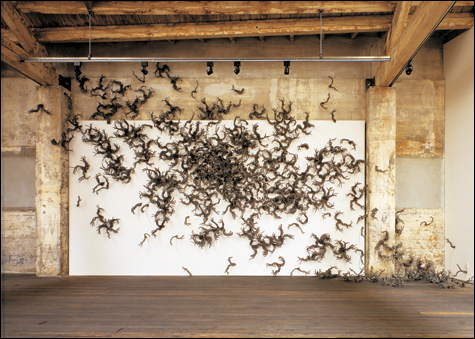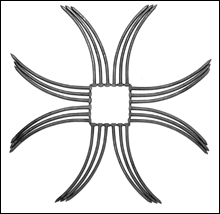John Bisbee's metalwork hijacks the Portland Museum of Art
By IAN PAIGE | January 30, 2008

"PLUME" 2001-2, from Ton series, welded 12-inch spikes. As installed at the artist's workspace. |
The Portland Museum of Art’s new exhibition immediately confronts you with the transformative power of John Bisbee’s sculpture. Two grids of monumental glyphs formed from flattened, twisted hand-forged nails climb up the walls of the museum’s Great Hall, communicating in an uninterpretable but strangely familiar language. You peer into the main gallery space to see an entirely different museum, spacious and with a warm, ambient glow: the mysterious dropstones of Bisbee’s work selectively illuminated with bright, focused light. Rather than beginning on a prescribed curatorial path, you can’t help but scan the sightlines reaching out to the distant corners of the gallery, each individual piece part of a well-manicured landscape. The actual space of the museum, at least in recent memory, has never looked so good.This spatial sensitivity translates to Bisbee’s sculptures. Each one is. Autonomous but adaptable to its surroundings, they are evidence of their unseen creator’s devotion to the ever-present moment, even when installing a piece from decades past.
Nails! That’s what we’re dealing with here, but you’ve got to get past that. Bisbee’s knack for constructing large-scale works composed of nails, brads, and spikes would surely have run out of steam in his twenty-odd years on the job if there weren’t something else at work here.
You might even be able to find that something in the exhibition, since it’s a retrospective. We are granted a rare opportunity to see a chronology of Bisbee’s work that would more likely be encountered individually. By examining nascent nail works from the late ’80s and recent synergetic experiments, we see Bisbee’s own transformation as human, artist, and teacher.
“Strong Box” from 1988 reflects his initial interest with the nail motif. Four windows allow the viewer to peer into a heavy, handled case. Buried inside, bristling, is a bed of upturned nails looking something like rusted moss. There is an intention inside the sculpture, and the metaphor is clear that it is not yet ready to see the light of day. The title of the piece, “Cocoon,” evokes a similar trepidation.

HAMMERED: Hand-forged nails, from
"Untitled," 2008, from Ton series. |
Quickly, in the relative scale of a life lived, Bisbee’s work moves from caged impulses to the playful, experimental, and didactic. The early ’90s bring about “Spool,” composed of a thin layer of nails, welded lengthwise to create a hollow cylinder. The weight of the nails is alchemically rendered insubstantial, each one appearing to float by the good grace of its neighbors.“Square” takes on the traditionally hung art object. Four layers of brads, thinly arranged in the style of “Spool,” are transposed to form a proxy canvas. Dimensionality is in constant flux. Two dimensions become four, then back to an illusive two, reminiscent of ice crystals on a window pane or bacillic bacteria under a microscope.
 Topics
Topics:
Museum And Gallery
, Visual Arts, Cultural Institutions and Parks, Museums, More  , Visual Arts, Cultural Institutions and Parks, Museums, Sculpture, Portland Museum of Art, John Bisbee, Less
, Visual Arts, Cultural Institutions and Parks, Museums, Sculpture, Portland Museum of Art, John Bisbee, Less 